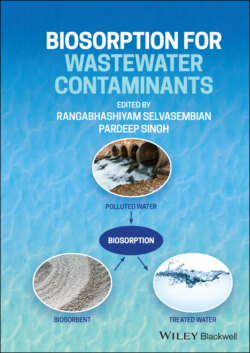Читать книгу Biosorption for Wastewater Contaminants - Группа авторов - Страница 18
Biocides
ОглавлениеA biocide is a substance or mixture that contains or generates one or more active substances to destroy, deter, render harmless, prevent the action of, or exercise control over any harmful organism by any means other than mere physical or mechanical action (ECHA, 2017).
Biocides can be used in different applications such as in‐can preservatives, film preservatives, and building materials, such as coatings and wood protection products. In addition, most of these compounds have a broad spectrum of uses and application, as shown in Table 1.1 (Bollmann et al., 2014).
The European Parliament and Council directive 2013/39/EU incorporated four biocidal compounds as priority substances: cybutryne and terbutryn, diuron, and isoproturon (mentioned in Table 1.1). Diuron and isoproturon belong to the phenylureas group. Isoproturon is a component used mainly for the protection of cereals. Diuron is a herbicide present in preparations used to prevent algae growth and is also used as an additive and antifouling agent (Durak et al., 2020).
Another very relevant group of biocides is the isothiazolinones. These substances can be present in cosmetics and as chemical additives for industrial use, as they have bacteriostatic and fungistatic activities or properties. However, they may represent ecotoxicological risks because they can cause irritation and allergies. This category of biocides has aroused interest in drug development due to its biological effects, resulting in an increase in patent applications related to these substances. Isothiazolinones most commonly found in commercial applications, alone or in combination, are methylisothiazolinone (MI), methyl chloroisothiazolinone (MCI), benzisothiazolinone (BIT), octylisothiazolone (OIT) and dichloroctylisothiazolinone (DCOIT) (Silva et al., 2020).
Industrial development provides greater exposure to biocides and other contaminants, which may be discharged in many environmental matrices. The occurrence of these substances in the environment is determined by environmental conditions, physicochemical properties, and anthropogenic factors (Durak et al., 2020) and has consequences in the form of acute toxicity to aquatic organisms and accumulation of toxic substances in the ecosystem, leading to decreased biodiversity and risks to human health (Mohr et al., 2008; Bollmann et al., 2014; Durak et al., 2020).
Table 1.1 Examples of biocides, activities where they are employed, and their types of products (BPD).
Source: Adapted from Bollmann et al., 2014.
| GroupCompound (abbreviation) CAS number | ActivityProduct types (BPD) |
|---|---|
| Triazines | |
| Terbutryn (TB)886‐50‐0 | AlgaecideBiocide: PT 7, 9, 10 |
| Cybutryn, Irgarol 1051 (IRG)28159‐98‐0 | AlgaecideBiocide: PT 21 |
| Carbamates | |
| Carbendazim (CD)10605‐21‐7 | FungicideBiocide: PT 7, 9, 10 |
| Iodocarb (IPBC)55406‐53‐6 | FungicideBiocide. PT 6, 7, 8, 9, 10, 13Cosmetics |
| Isothiazolinones | |
| Methylisothiazolinone (MI)2682‐20‐4 | Bactericide/FungicideBiocide: PT 6, 11, 12, 13Cosmetics |
| Benzisothiazolinone (BIT)2634‐33‐5 | Bactericide/FungicideBiocide: PT 2, 6, 9, 11, 12, 13 |
| Octylisothiazolinone (OIT)26530‐20‐1 | Bactericide/FungicideBiocide: PT 6, 7, 9, 10, 13 |
| Dichlorooctylisothiazolinone (DCOIT)64359‐81‐5 | Bactericide/FungicideBiocide: PT 7, 8, 9, 10, 11, 21 |
| Phenylureas | |
| Isoproturon (IP)34123‐59‐6 | AlgaecideBiocide: PT 7, 10 |
| Diuron (DR)330‐54‐1 | AlgaecideBiocide: PT 7, 10 |
| Triazoles | |
| Tebuconazole (TBU)107534‐96‐3 | FungicideBiocide: PT 7, 8, 9, 10 |
| Propiconazole (PPZ)60207‐90‐1 | FungicideBiocide: PT 7, 8, 9 |
| Miscellaneous | |
| Mecoprop (MCPP)93‐65‐2 | AlgaecideRoof protection (not registered under BPD, since higher plants) |
BPD, Biocidal Products Directive; PT, product type.
In response to these problems, environmental agencies have made an effort to restrict and/or regulate the use and disposal of biocides. At the same time, the scientific community aims to study efficient treatment processes to remove them from wastewaters, whether domestic or industrial.
Different processes have been tested to evaluate an efficient treatment approach for industrial wastewaters. AOPs have been tried to oxidize organic compounds, which are difficult to convert into biologically less‐harmful final products (Pirilä et al., 2015). Pirilä et al. (2015) studied the photocatalysis process to treat four biocide compounds, including diuron, which is commonly used as a herbicide in agriculture, leading to contamination of the aquatic environment due to leaching from the soil. The elimination of this substance from wastewater is important due to its toxicity to photosynthetic organisms. This study revealed that diuron was removed more efficiently and with minimum energy consumption (Pirilä et al., 2015).
AOPs can also be applied in combination with other processes to treat biocides, as in the study carried out by Vanraes et al. (2018), who developed and optimized a reactor that combines oxidative treatment by dielectric barrier discharge (DBD) with adsorption of micropollutants on activated carbon and with additional plasma gas. The objective was to minimize the formation of dangerous oxidation byproducts from the treatment of persistent pesticides, including diuron and isoproturon. The authors observed that activated carbon in DBD reactors causes a synergistic effect in removing pollutants and that DBD reactors allow the regeneration of activated carbon, increasing the life of the reactor (Vanraes et al., 2017; Vanraes et al., 2018).
